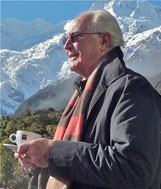Language and inhibition
In the interesting first chapter of The Transformations of Man (1957)—a chapter titled ‘Animal Into Human’—Lewis Mumford considers the early development of human language. He is less concerned with its origin, per se, and more with its cognitive effect. He makes the following observation:
Language, the most important agent of directed thought, has the special trick of inhibiting autonomous images. Once language is achieved words may indeed summon events or images into consciousness: but when they function actively they may also, as the busy, efficient agents of directed thought, halt the self-induced hypnosis of sleep.
This fact is well known to those who have been sleepless. If primitive man was at first almost a neurotic victim of his own excessive image-making power, the invention and elaboration of language may have acted as a helpful inhibiting agent, which kept him from being overwhelmed.
By displacing autonomous images that welled up from the unconscious with verbal symbols attached to conscious processes, he may have brought his whole life under greater control.
Much primitive thinking would still remain dreamlike, infantile, magical. But by the very nature of the word, thinking itself would become centrally directed, and in time, by its very detachment from the unconscious, it would serve to enlarge the realm of the rational, the intelligible, the practical. (My emphasis here and elsewhere, RS)
Now the thing to notice here is the thesis that language ‘inhibits’ free-floating imagery and thereby assists in making the flood of sensory experience manageable. The use of the word ‘inhibits’ is in itself striking: we normally think of language as facilitating or enabling, as adding rather than reducing. But if Heraclitean flux is to be reduced to Parmenidean stasis, and held steady for contemplation, then at the level of human consciousness something like this has to happen.
We could use other expressions to make the same essential point. We could say that language excludes everything not explicitly denoted; that a primary task for the organism is to create for itself a closed environment wherein its own life purposes can be attended to; that linguistic stability is of Darwinian significance. Exclusion, closure, and stability all seek to manage and control the sensory flood.
Raymond Tallis
Tallis makes a number of comments in The Human Animal that bear on this question. He too is concerned with the emergence of the distinctively human and the origins of language. At 1.1 : “…mental images are unstable and private (or uncommunicable), whereas the meanings of words have to be stable and public…” That meanings are made public is part of Tallis’s argument about the nature of knowledge. But that mental imagery is dangerously unstable is what concerns us here. In contrast, verbal stability reduces sensory excess.
At 1.1 he quotes John Searle to the effect that “In speaking, I attempt to communicate certain things to a hearer by getting him to recognize my intention to communicate just those things.” We might add that it is the rules of grammar that enable us to communicate just those things: predication and tense add further definition, excluding unstable and unwanted areas of ambiguity and (in informational terms) ‘noise’.
At 3.1 Tallis tells us that knowledge is shadowed by a sense of ignorance. “Knowledge knows that it is underdetermined: it is haunted by incompleteness… we are aware that what we know is a small island in an infinite sea of the unknown.”
The ‘haunting’ might be seen as a by-product of verbal and grammatical stabilization and inhibition: the vast superfetation of unstabilized flux which is necessarily left out as both superfluous and unmanageable is felt to be vaguely threatening, and returns in dreams… The island metaphor may be applied to words, to grammar, to knowledge, and even to the origin of life itself.
Paul Davies
The cosmologist Paul Davies recently had something to say about stabilization and the value of slower relatively inert “islands in the stream” considered as evolutionary phenomena. He was speculating about the origins of life. (Sydney Morning Herald, 22.12.05):
“How, then, did life arise? We can gain a clue from modern computers. Quantum systems may be fast, but they are very fragile. Computers routinely transfer important data for safekeeping from speedy yet vulnerable microchips to slow and bulky hard disks or CDs.”
“Perhaps quantum life began using large organic molecules for more stable data storage. At some stage these complex molecules took on a life of their own, trading speed for robustness and versatility. (RS: It might be noticed that a Darwinian assumption has been smuggled into the preceding sentence. ‘Trading’ means robustness and stability trumped speed as a survival mechanism.) The way then lay open for hardy chemical life to go forth and inherit the earth.”
J. G. Roederer
Davies’ unacknowledged source for these speculations appears to be a book by J. G. Roederer (which Davies had earlier reviewed), Information and Its Role in Nature. (Springer-Verlag Berlin Heidelberg, 2005) A physicist, Roederer writes about “The Genesis of Complexity and Information.” I here draw out from his discussion relevant statements about stabilization, structure, and the formation of “islands of stability”.
3.1 Although our book does not deal with cosmology, we must examine some relevant aspects of physical and chemical evolution… They are: fluctuations and change (and) formations of ‘islands’ of stability.
After a discussion of kinds of fluctuations in the universe, some of which are transient, and others that surpass some critical size and “trigger instabilities which grow and lead to macroscopic consequences”, he writes in a Darwinian fashion of
The selective advantage of certain structures vi-à-vis others… (author’s emphasis) Recall that we mentioned the great fragility of any artificial quantum system prepared in the laboratory… There are, however, states that are robust and immune to tenuous external influences… Thus, in the primordial subatomic world stable configurations emerged as the ‘survivors’ in a sea of chaotic fluctuations: first the elementary particles, then atoms and later molecules. (83)
Thanks to peculiar physicochemical properties of the molecules involved, one particular class of carbon compounds takes off on a development of its own, not just recently on Earth but long before on the surface of icy comets and planetary moons.
Indeed, there is a ubiquity of simple organic molecules such as HCN, light hydrocarbons, even simple amino acids and polymers, which in the favourable environment of Earth have developed the capacity of information-driven interactions and given rise to living organisms — membrane-encapsulated ‘islands’ of self-organization with reproductive capacity, able to maintain a low entry state in metastable equilibrium with the environment. (85)
On page 90 Roederer concludes section 3.1 in a longish paragraph (here broken up and lightly edited) bringing together the concept of spontaneously organized ‘islands’ in the flux, with the different concept of organization brought about by intelligent human intervention:
We mentioned above the selective advantage of some particular component structures in terms of their stability or ‘survivability’ in an evolving Universe. Other structures are possible and may have formed during the course of evolution, but if they did, they were evanescent and did not lead to any stable ‘islands’ of increasing organization.
Today, however, we can produce new isotopes, new organic molecules, new nanostructures, new chemicals, new breeds and clones, even new virus-like or cell-like entities that have not undergone any natural, selective evolution.
These actions have all been planned and designed with a premeditated goal—a very different process, requiring the intervention of a human brain. Here, indeed, we must appeal to the concept of information and its intervention in the physical world!
It is human intention and action that is now generating and preserving these new products—structures that emerge not from physical laws alone but from brain information processing which causes deliberate, planned changes in the initial conditions that enter into the laws governing the systems under consideration.
Summary
We began by looking at a little-noted aspect of language and suggesting that what Lewis Mumford called its “inhibiting” function is another way of describing a way of achieving, cognitively, an ‘island’ of order in the sensory storm.
We next saw each evolutionary development of language—labelling, comparing, fixing in time and space—as removing ambiguity and strengthening cognitive control. The haunting “shadow of ignorance” is seen as a lingering apprehensive awareness of how little of the world is securely grasped.
Roederer, a physicist, then provides historical depth by describing analogous cosmological processes. Putting our comments on language into this framework we see (a) an initial stage of self-organizing complexity arising from nothing more than fluctuations in the early Universe, (b) a later stage of complexity arising from as yet unidentified causes leading to the membrane-encapsulated ‘islands’ of living organisms, and (c) a more-or-less unconscious development by which language itself imitates an aspect of the process of physical self-organization.
Each word, phrase, sentence, helps define a part of the sensory flux, eliminating the distractions of the surrounding sea, forming an island of stable meaning, and holding it cognitively steady for examination.

 An Australian writer living in Sydney, Roger Sandall is the author of The Culture Cult (2001), a study of romantic primitivism and its effects. His work has appeared in a number of places including Commentary, The American Interest, Encounter, The New Criterion, The American, Sight and Sound, Quadrant, Art International, The New Lugano Review, The Salisbury Review, Merkur, Mankind, Visual Anthropology, and Social Science and Modern Society.
An Australian writer living in Sydney, Roger Sandall is the author of The Culture Cult (2001), a study of romantic primitivism and its effects. His work has appeared in a number of places including Commentary, The American Interest, Encounter, The New Criterion, The American, Sight and Sound, Quadrant, Art International, The New Lugano Review, The Salisbury Review, Merkur, Mankind, Visual Anthropology, and Social Science and Modern Society.